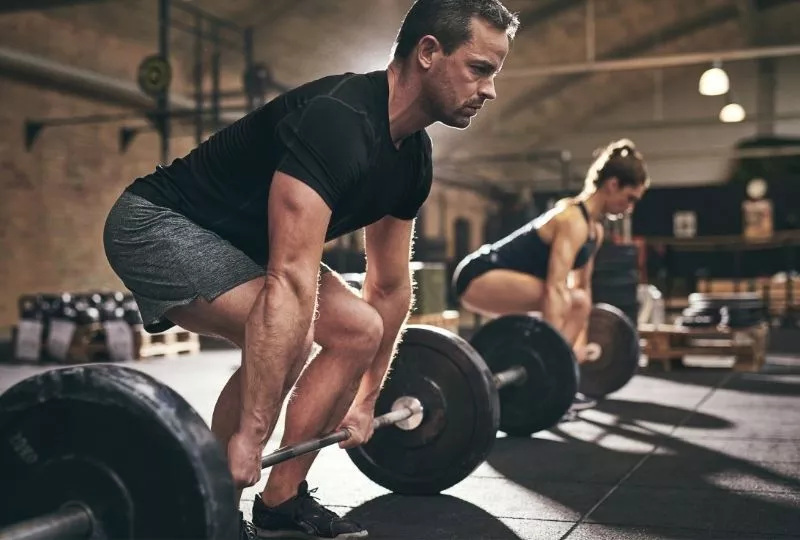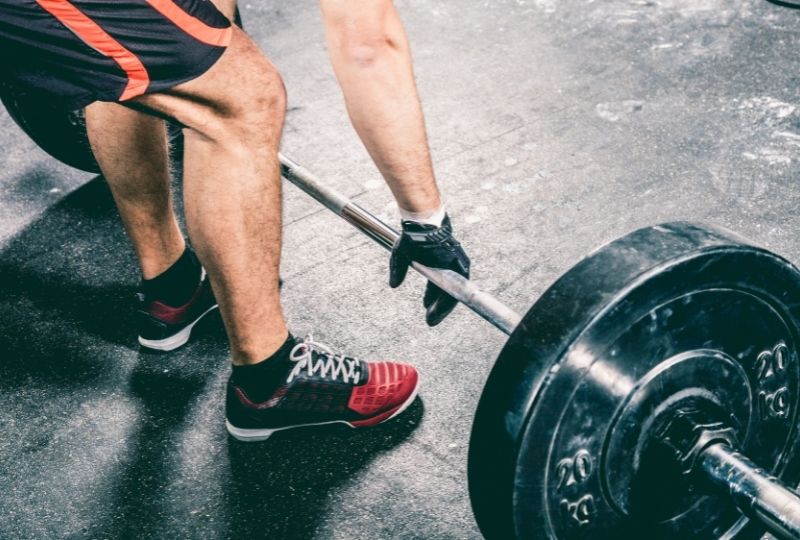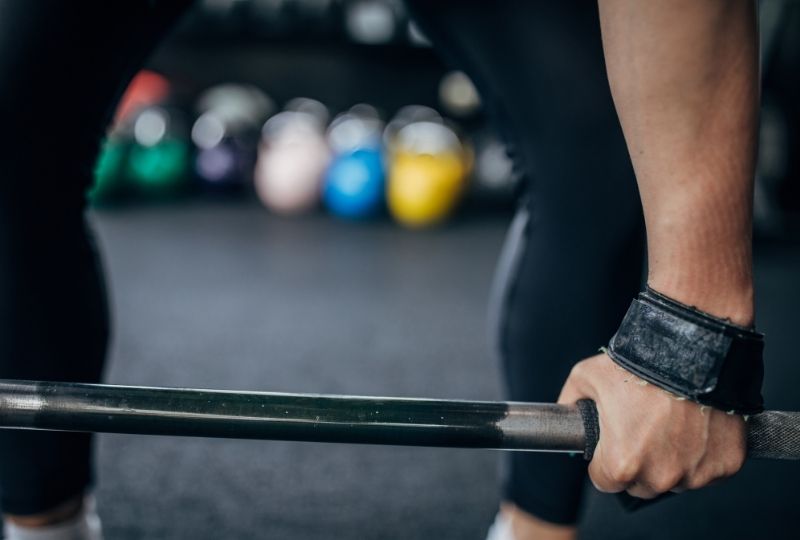What's inside
The deadlift is one of the fundamental exercises for increasing overall muscle strength and development.
One of the reasons for its popularity is that it allows you to lift some of the heaviest loads possible by a given individual.
But, as anyone who has been developing their maximal deadlift will attest, one of the most common limiting factors in this exercise is grip strength.
There are several workarounds to deal with this issue. One method which is becoming more widely used is the hook grip deadlift.
This article will detail exactly what a hook grip deadlift entails and how to use it to maximize performance and minimize injury risk.
We’ll also cover how the hook grip stacks up against other deadlift techniques and provide you with a trial program to determine if the hook grip deadlift is for you.
What is the hook grip deadlift?
Related: What Is Functional Strength Training?

The hook grip deadlift is a technique used in maximal deadlifting. It involves hooking the thumb under the index and forefingers for improved grip.
The hook grip is one of several methods used to allow lifters to create more friction on the bar. This way, they can lift a heavier weight with less chance of dropping the bar.
The hook grip deadlift also helps counteract the substantial demands placed on the forearm muscles during the movement.
In a conventional deadlift, the forces placed on the barbell in the upward phase cause the bar handle to rotate toward the lifter.
This can cause the bar to move in the hand, putting more stress on the smaller intrinsic muscles of the hand and forearm.
The hook grip counteracts this rotational force by locking the bar in place with the thumb.
However, there are other ways to achieve this. The hook grip just recently became one of the more popular methods.
Next, we’ll compare the hook grip deadlift with its more commonly used counterpart, the mixed grip deadlift.
Hook Grip vs. Mixed Grip Deadlift: Which one is better?

For those initially building their deadlift, the double overhand grip is the most commonly recommended method by coaches.
This is because it places the upper limbs in a symmetrical position for improved biomechanics and less risk of injury.
But once many lifters get to a certain intensity in their deadlift, grip strength often becomes the limiting factor.
It is at this point that many trainees opt for either a mixed grip or hook grip deadlift.
Research has found that while both grip methods aid in increasing maximal loads lifted in the deadlift, there were differences in their effects.
The mixed grip was perceived by many subjects as the easiest grip, with less forearm muscle stress perceived.
However, the hook grip is recommended as the more optimal way to maximize muscle activation and develop grip strength more effectively.
The mixed grip is also a cause for concern for some fitness professionals as there is potentially more risk to the biceps tendon of the supinated arm.
Both the hook grip and the mixed grip can be used by lifters who are becoming limited in their deadlift by their grip strength.
Later, I’ll share a method to determine which of these grip techniques might be best for you.
But first, for those eager to give it a try, let’s take a look at how to properly perform the hook grip deadlift.
How to Hook Grip Deadlift
The hook grip deadlift is mainly defined by the grip technique, but it can look very different depending on who is performing the movement.
It can be used with the conventional deadlift, sumo deadlift, or straighter leg variations like the Romanian deadlift.
It can also be used regardless of the width of an individual’s grip. Some athletes opt for a wider grip in certain cases.
There are three elements to performing the hook grip deadlift:
Intent
An underrated aspect of any deadlift grip is simply squeezing the bar as hard as you can.
Many people fail in their grip during a deadlift simply because of lazy setup and losing grip from the outside in.
While using a hook grip – or any other deadlift grip – make sure that from the hand placement until the end of the set, you are trying to crush that bar as hard as possible.
This means squeezing with all five digits, ring finger and pinky included.
In fact, elite strength coaches often say that the fourth and fifth fingers are the first to give out in heavy grip work.
Try pinching heavy paper clips between your ring or pinky finger and thumb, in addition to visualizing each finger pulverizing the barbell during your deadlift.
Technique
Setting up for a hook grip is just the first step in performing a deadlift with good technique.
Assume your optimal starting position with the feet and body in alignment in front of the barbell.
Use the following steps to employ the hook grip technique for your deadlift:
- Choose a suitable grip width on the bar.
- Drive the bar deep into the crease at the base of your thumbs.
- Wrap your thumbs under and around the bar.
- Close your forefingers just over the distal knuckle of the thumbs.
- Close your middle fingers over the thumb between the fingernail and knuckle.
- Wrap your ring and pinky fingers around the bar.
- The tip of your thumb may poke between your middle and ring fingers.
- Squeeze as hard as you can as you set up and perform the deadlift.
Strength
The third aspect of performing a hook grip deadlift is general grip strength itself.
While the hook grip, mixed grip, or lifting straps can all help develop strength, the ideal scenario is simply to improve your grip strength overall.
Luckily, grip strength is something that can be developed relatively quickly when given adequate attention in the gym.
It is important that you develop your grip strength specifically for the deadlift. Working endurance with lighter weight won’t necessarily help you hold a heavy deadlift.
For a comprehensive guide on the importance of grip strength, and how to improve it, check out our article on the subject.
Also, keep in mind that while grip strength is critical for your continued progression in the deadlift, it is not the primary muscle group of the exercise itself.
The forearm muscles act with the muscles of the upper back and arms as static stabilizers. Meanwhile, the glutes, hamstrings, quads, and lower back perform the dynamic movement.
Next, let’s discuss use cases for who stands to benefit the most from using the hook grip.
Who is the hook grip deadlift best for?
Related: Tips For Building A Well-Defined Back

The hook grip is most useful in the case of competitive powerlifters who need to compete ‘raw’, or without the use of certain aids.
While the use of chalk is permitted in many powerlifting meets, equipment such as lifting straps is not allowed in some forms of competition.
The hook grip deadlift might not be ideal – or even feasible – for those with smaller hands, such as females or youth lifters.
It is also not suitable for individuals with pain or injury in the tissues of or around the thumb, as there is a lot of tension placed on the thumb itself.
For the majority of regular gym-goers who want to increase strength and muscle, lifting straps may be a better alternative than either a mixed or hook grip.
Lifting straps eliminate the risks of either grip method while improving performance, lowering exertion, and facilitating better grip strength recovery after deadlifting.
For those who do want to use the hook grip rather than aids like straps, there are some benefits to this method.
Hook Grip Deadlift Benefits
Related: 10 Week Powerlifting Program
The following are some of the most common reasons people tend to use the hook grip for their deadlift:
- Creates more friction between hand and bar
- Stops bar rolling out of fingers
- Avoids risk to biceps tendon from supinated position (mixed grip)
- Increases grip strength
- ‘Raw’ technique – no straps required
The hook grip can be used in many other exercises in addition to the deadlift.
Some examples include bodyweight exercises like dead hangs or pull-ups, compound barbell movements like cleans, and even dumbbell exercises like one-arm rows.
As mentioned, the mixed grip deadlift is more widely seen around gyms today, but the hook grip is definitely gathering more of a following in recent years.
Common Mistakes with Hook Grip – Tips to Avoid Injury
To minimize hook grip injury risk, avoid these common mistakes:
- Pressing on the nail
- Pressing on the joint/knuckle
- Overreaching the thumb
- Placing the bar too high in the palm
- Letting go of the bar while off the ground
- Having sweaty hands – Use chalk/tape
To reiterate an important point, most people looking to improve their deadlift strength should use lifting straps in combination with grip strength training.
Even with good technique and sufficient preparation for the hand and thumb, the hook grip does put more torsion and compressive force through the thumb joints.
And although it will become more bearable over time, the hook grip will always be a bit uncomfortable compared to conventional grips.
Deadlift Grip Trial Program – Determine the Best Grip for You
See Also: Why Do Bodybuilders Tan?
The following is a simple protocol for testing your deadlift one-repetition maximum (1RM).
You can perform this protocol several times, each with a different setup for your lift.
Try it with a standard overhand grip, a hook grip, mixed grip, or with lifting straps.
You can also use this to compare your performance with other deadlift variables, such as sumo versus conventional foot stance.
Only perform the protocol with one grip type in a given session. Leave two to three rest days between trials.
You can train other body parts on the days between, just ensure you are well rested to get an accurate comparison of your results.
Not only can you use this self-test to see which grip allows you to lift the most weight, but you can also trial which deadlift grip feels the most strong and secure for you.
You’ll also uncover any issues with certain grips at lighter warm-up loads before trying new grip styles at higher intensities.
| Reps | Load (%1RM) | Rest |
| 8-10 | 40% 1RM | 1-2 mins |
| 5 | 60% 1RM | 2-3 mins |
| 3 | 80% 1RM | 2-3 mins |
| 1-2 | 90% 1RM | 3-5 mins |
| 1 | 95% 1RM | 3-5 mins |
| 1 | 100% 1RM | 5 mins |
| 1 | 100%+ 1RM | – |
If you do decide to go with a new grip variation after trialing this protocol, make sure you introduce it slowly into your routine.
Here is an example schedule for incorporating the hook grip into your deadlift regime:
- Week 1: Perform first warm-up set with hook grip
- Week 2: Perform all warm-up sets with hook grip
- Week 3: Perform first working set with hook grip
- Week 4+: Perform all desired sets with hook grip
Frequently Asked Questions

Is hook grip good for deadlift?
While each case is unique, the deadlift hook grip can improve grip strength and allow you to improve your deadlift loads.
For those with suitable hand size and health, and who don’t want to (or can’t) use lifting aids such as straps, the hook grip is a proven technique for increasing deadlift strength.
Do powerlifters hook grip?
Many elite powerlifters use various grip techniques.
As mentioned, in certain competitions, athletes must perform their lifts ‘raw’, meaning they’re not able to use lifting straps or other aids.
This means powerlifters at the highest level have to employ any method they can to increase their strength and total numbers.
The hook grip can be combined with chalk or strapping tape around the thumb (where allowed) to create more friction and less movement of the bar in the hands.
Can hook grip damage your thumb?
Like many exercises and techniques in the fitness world, risks of injury arise mainly when the improper technique is used.
When performed by a suitable person, with the correct technique, the hook grip is a perfectly safe method to use.
That being said, the deadlift hook grip is definitely uncomfortable at first and takes some getting used to.
Which grip is best for deadlift?
The best grip for the deadlift depends on your goals for the exercise.
If you are aiming to lift the most amount of weight possible, the best grip will be whichever variation permits this for you.
For anyone who doesn’t need to lift ‘raw’, but finds that grip strength is becoming a liability, here is my personal recommendation.
Use lifting straps to allow you to continue progressing your maximal intensity while simultaneously allocating more training time to grip strength.
Final Thoughts
So, what are your thoughts on our guide to the hook grip deadlift?
Let us know which deadlift grip – and any lifting aids you use – in the comments.
If you know anyone who is being held back by their grip strength, feel free to share this article with them as well.

